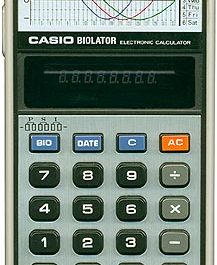
The Casio Memory-10 or H-1010 was a handheld calculator introduced in 1976 by Casio Computer Company Ltd. Measuring approximately 75mm x 135mm x 22mm and weighing 128g without batteries, this calculator was a solid slab-shaped device with a smooth plastic case featuring a white base and black and white front.
The calculator was powered by two AA batteries or an optional AD-2S 3V 0.3W adapter, with an on/off switch located on the left side near the Casio logo. It featured a 10-digit blue vacuum fluorescent display (VFD) without an eleventh digit. The display filter was flat and slightly recessed, providing a clean, bright image.
Despite its familiar Casio design elements, the Memory-10 offered standard four-function calculations with percentages, square roots, and a three-function memory. It had a floating-point mode and a two-decimal-point mode selectable via a front switch.

The calculator’s internal components included a Hitachi HD3692A 5L 11 CPU, a single-tube round-face LD8139 10-digit VFD, two transistors, five diodes, 17 capacitors, five resistors, two resistor arrays, and a transformer. The keyboard assembly was attached to the front with six screws and connected to the main CPU board via 13 wires.
Logic:
- The (C) key canceled an entry, while the (AC) key cleared the entire calculator.
- Input overflow was suppressed, and entering an eleventh digit was ignored.
- Negative numbers were displayed with a “-” in the immediate left digit, limited to seven digits.
- Double-hitting the multiply or divide operator enabled a constant operation.
- Negative square roots were allowed, resulting in a negative number.
- Division by zero showed “E” in the far-right digit and was unrecoverable.
- Overflow showed only “E” in the far-right digit and was unrecoverable.
- Memory storage was not indicated, and (AC) cleared the memory.
- Users could switch between full floating-point and two-digit round-down notation.
Overall, the Casio Memory-10 was a solid, slab-shaped calculator with a familiar Casio design and standard features for its time, although its logic and negative number handling were somewhat limited compared to modern calculators.


